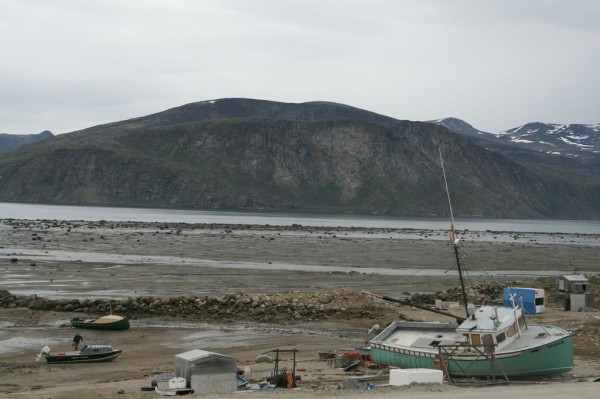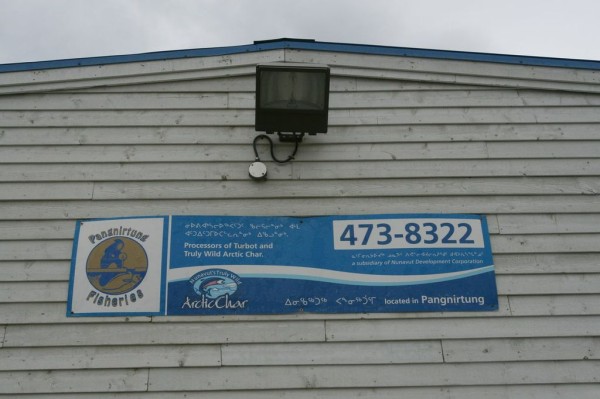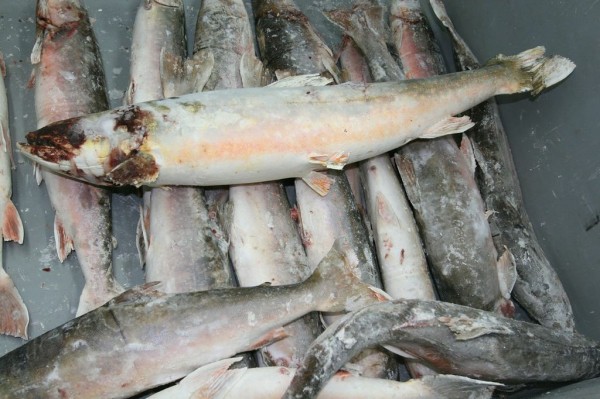Students on Ice: Fishing for Global Solutions in Pang
“What kills a fishery is the banker” says Trevor. We’re standing outside the Pangnirtung fish plant, looking out at the rocky flat, left bare by the low tide. A fishing boat leans into the mud, as if stranded on the shore. Trevor Taylor knows a thing or two about fish. Now with Oceans North, he’s the former NL Minister of Fisheries and former fisherman – and to hear him talk (when I can understand that charming Newfoundland accent) – he’s more at home on a boat than anywhere else. Has more photos of ships than of his kids, he jokes.
View of the bay leading out to Cumberland Sound
We’re guided through the plant by another East Coaster, James from Glace Bay, Nova Scotia, who manages the operation in Pang. There’s no fish there today, save what’s already been frozen and packed from the last catch. The plant processes Turbot (Greenland Halibut) and Arctic Char, and there’s not much fishing that takes place during the summer. That may change though. There’s a plan on the horizon to commission more boats, hire more captains, and haul in an additional catch of Tubot in late July. Considering the plant employs about 50 people – a meaningful percentage of the working population – the potential for growth is a pretty big deal. But one that raises some equally big questions, especially around fishing quotas. “There’s lots of fish in these waters,” James says. And he would know as well as anyone. But there’s been no scientific assessment of the stock here, no way to really know the ecological limits. Maybe another 4 boats on the water would be okay? Maybe 5? But who can say. What Trevor knows is that once you have too many boats in the water, it’s near impossible to take them off. “At the end of the day the banker has to be paid and fishing boats are paid for by fish”, Trevor reminds us, “and it is easier on the fish and the people to get that mix right from the start.”
Welcome to Pangnirtung Fisheries (Nunavut)
But understanding Pang’s fishing economy is also about understanding where those fish are going once they’re pulled from the water – and in what state. James shows us a piece of complicated, expensive machinery for skinning and filleting the fish (it pulls off the skin through a freezing process, like ripping your tongue off a frozen pole – a gross but fairly accurate metaphor). It sits dormant in a corner, practically decommissioned. That’s because the real money today is in sending whole fish, flash frozen, to China. In some cases that is because food preparation and regional preferences demand whole fish (after all, Trevor says, no one wants to order a lobster and get a plate of canned meat). But mostly it’s because it’s simply cheaper to process fish into fillets in China than it is here in Pang. We could have been talking about wood or oil, I thought. The question of whether Canadians reap the most benefit from the development of their raw natural resources is echoed profoundly here.
And if we were still left wondering how a small fish plant on the coast of Pangnirtung, Nunavut is connected to the far-reaching, global challenges of today’s fishing industry – Trevor asks us to think about what it means to fish here in the winter time. It means snowmobiling over the frozen bay to the flow edge, where the deep water runs. But warmer temperatures mean shrinking sea ice. There have been winters when people couldn’t get far enough out into Cumberland Sound to make a catch, or have risked their lives – perhaps – trying.
Tonight, after a long day of hiking, we’ll sit down to feast on Pang’s Arctic Char. But what we’re really getting a taste of are the tremendous questions and challenges that ripple across our international fishing sector. We owe it to the people of Pangnirtung and the Greenland Halibut of Cumberland Sound to find the right answers.
Frozen Arctic Char ready for shipping




